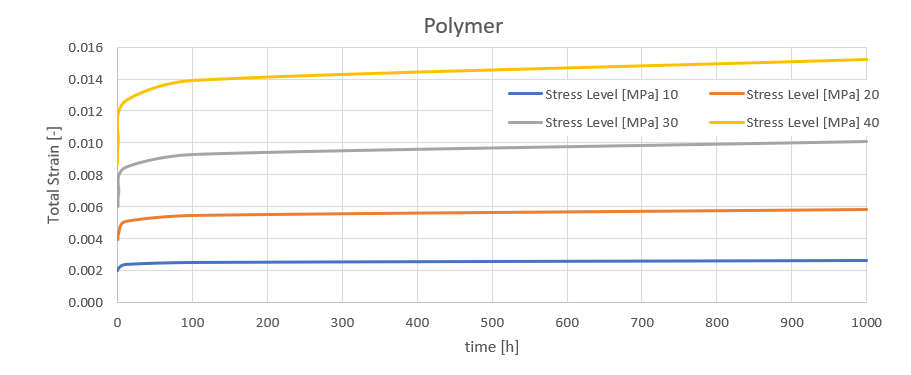TAGGED: prony-series, visco-elasticity
-
-
April 7, 2025 at 10:53 am
georg.gruber
SubscriberDear Ansys Community,
I want to set up a viscoelastic material model based on creep curves (stress vs. time curves for various stress levels). The curves could look like this:
The material model should be based on prony series, what is already implemented in Ansys. The material model can easily be set up based on shear relaxation curves (which I don't have). Since creep curves - as shown above - are much more common (the experimental setup is much simpler) I asked myself, if there is also a method to get the prony series parameters based on creep curves.
I know creep material models (like mod. time hardening) can directly by setup based on creep curves (there is a curve fitting procedure accessible in Ansys Classic). In my case, I'm specifically interested in the viscoelastic approach.
Many Thanks in advance.
Greetings,
Georg -
April 14, 2025 at 8:33 pm
John Doyle
Ansys EmployeeThe Prony Series expression is intended to be superimposed on a rate independent base material model (either linear elastic or hyperelasitic). The experimental data input for curve fitting must be shear modulus vs time (or frequency) and/or bulk modulus vs time (or frequency). Please refer to Table 7.19 of the MAPDL Material Reference Guide (Release R2025-R1). Since the Prony coefficients (alpha factors) are unitless ratios representing relaxation for a corresponding relaxation time, you can substitute stress components that are proportional to modulus values to get the same result. Since strain equals stress/modulus, you might be able to convert the data you have to stress vs relaxation time, if you have the modulus values and/or if you know the load and cross sectional properties of the test coupon used to generate this test data.
-
April 17, 2025 at 10:35 pm
Dennis Chen
SubscriberHello, georg.gruber. linear viscoelasticity, which is implemeneted as a linear elastic material model with a set of prony series terms, is usually generated from a DMA master curve. From there, you can compute the instantaneous and long term modulus. Using a maxwell model, one can establish the viscoelastic response using a general form such as one shown below
Below paper provides a good summary – https://www.redalyc.org/journal/404/40465092006/html/#B16
I post these because I don’t get how one can get this from looking at a creep curve. If you have a good reference you are willing to share that explains the methods, I would really love to learn.
Thank you!
-
- You must be logged in to reply to this topic.



-
3019
-
971
-
857
-
783
-
772

© 2025 Copyright ANSYS, Inc. All rights reserved.









